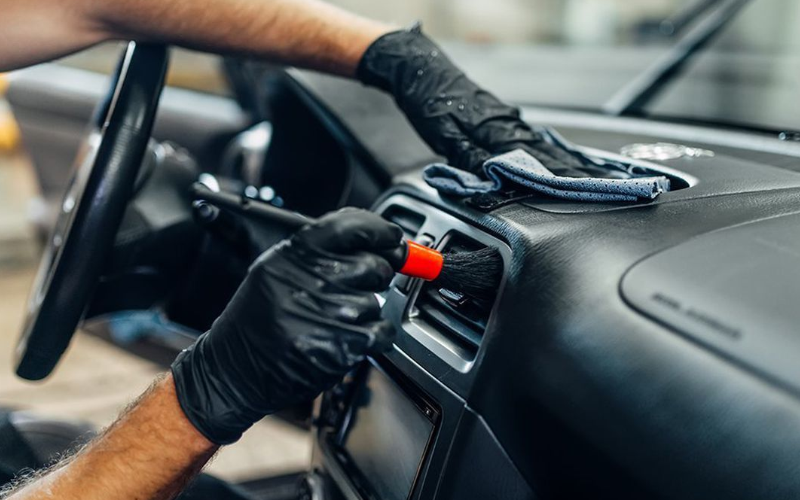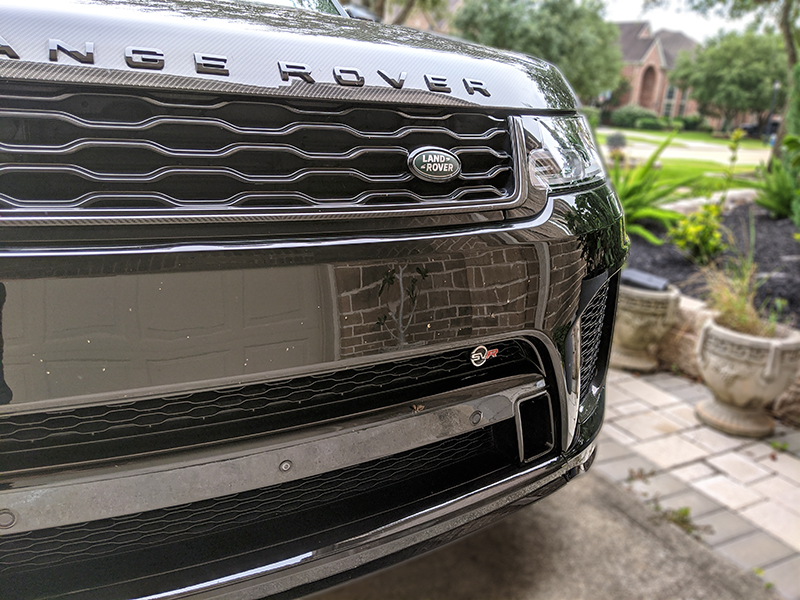Car detailing is a growing industry in the United States. In 2021, the car wash and auto detailing market in the US is estimated to be worth $11.5 billion according to ibisworld.com. That’s up from $10.3 billion in 2020. It’s both a profitable business for those who want to take up car detailing as their new profession, and an expensive service for those who want to clean and restore their cars to a near-new look.
Because of this, there are two big reasons that you might want to build up your own professional-level detailing kit. Either you are interested in getting into the world of detailing yourself to make extra money, or you are looking to recreate the effect of car detailers on your own. In both cases, you’ll need the proper tools and equipment, and that’s what today’s blog is all about.
Below you’ll find our guide to building your own professional car detailing kit.
First, a summary of the equipment you’ll need for your kit, which we will then introduce in more detail underneath:
Exterior:
- Buckets
- Cleaning agent
- Foam cannon
- Washing mitts
- Microfiber towels
- Power washer (& hose)
- Brushes and applicators
- Blower
- LED Lamp
- Orbital Buffer
- Clay bars
- Wax/Sealant
Interior:
- Vacuum cleaner
- Steam cleaner
- Pet hair removal brush
- Storage solutions – A Detailer’s Toolbox
Car Detailing Means Deep Cleaning Outside and Inside
Remember that when you’re getting into car detailing, your goal isn’t simply the removal of dirt, grime and other contaminants from a vehicle’s various surfaces. That’s obviously a very important part of the process, but it’s not the main goal overall. The extra element in car detailing is restoration.
Your goal when you are detailing is to put both the exterior and the interior back as close as they were when the vehicle was brand new. Removing dirt is easy, but achieving that feeling of restoration is the real challenge of car detailing.
Exterior Cleaning Kit:
Buckets
You’ll need at least two, but if you want a really professional-like detailing kit you might want to look into a whole host of buckets to have on hand just in case. You’ll certainly need at least two for each cleaning job. The first bucket is for water mixed with your main cleaning agent; the second bucket should contain only fresh water.
What can be a very useful additional feature of these buckets is for them to have dirt traps. The idea of the two-bucket system is that you are able to wash off the dirt and impurities in the water-only bucket, of course, but any way that you have to make the water buckets more effective at capturing any kind of stray dirt, gravel, grit and anything else is always a big advantage.
Ensure that the buckets are durable, lasting and made with quality materials so that you won’t be switching to new buckets every week. You don’t want your kit to be too wasteful, after all.
Cleaning Agent
The next goal you have is to get the right detergent or other cleaning agent. The first thing to note is that your professional detailing kit must under no circumstances have any product that was otherwise intended for use in your home or other application. Car detailers use car-specific products. In other words, you need shampoos, cleaners and other agents that are formulated to work on car paint without damaging it, and on car wheels without causing any irritation, corrosion or other nasty effects.
Household detergents like dish-washing liquid, for instance, which often gets thrown into one of the car-washing buckets, are made with materials that are quite harsh on your car and were not designed for use on car paint or any other surface of the car outside or in.
Look to brands like Chemical Guys, Meguiar’s and other car-specific cleaning products, all of which get rave reviews from detailers for their quality and efficacy.
Foam Cannon
A foam cannon is a great tool to use in conjunction with a power washer (see further below). It’s not absolutely an essential part of any car detailing kit, but it will certainly add a professional edge. As the name suggests, a foam cannon is a powered tool that helps you apply the cleansing foam of your cleaning agent across your car more evenly than you would just using your washing mitt (more below) and buckets.
The foam cannon sprays the foam out much as the power washer sprays fresh water. You can then quickly apply an even layer of cleansing foam across the entire car before rinsing and drying each section easily.
Washing Mitts
Washing mitts are an extremely important addition to your kit whether you plan to use a pressure washer and foam cannon or not. Ultimately, you’re going to need a washing mitt sooner or later in order to get that close and deep cleaning effect that you want when detailing.
Washing mitts are exactly what they sound like. They are basically gloves that you wear and then wipe over the car’s surface to apply or remove cleaning agent. They are made from soft materials, usually, and soft is usually good.
Our main advice with the washing mitts is never to skimp on the quality of these mitts, even if it ends up costing you more. The washing mitt is to the auto detailer what the fine Italian horsehair paintbrushes are to the fine artist — the make a huge difference. Invest in quality washing mitts that will absorb when they need to, clean when they need to, and above all won’t become a dried-out, scratchy surface at any point.
Another good habit is to use more than one mitt in each wash. You could one mitt for the cleansing and cleaning part on the soapier surface, and a second mitt for the rinsing stage where you’re removing the last of the cleaning agent. Washing mitts, like microfiber towels (see below) are one of those things of which a detailer can’t really have too few.
When storing your spare washing mitts, however, ensure that they are always kept off the floor and in a sealed or enclosed casing where they won’t gather dust or dirt while they wait to be used. If the products arrive sealed in plastic, don’t open them until you are ready to use them.
Microfiber Towels
Microfiber towels are just one of the tool you can use to dry the car’s surface once you have finished washing it. The alternative to these towels is using a heat blower (see below), but if the budget doesn’t stretch to all the machines on this list, then microfiber towels work very well.
In the world of detailing, you simply cannot ever have enough fresh and clean microfiber towels available. Obviously, you should use washable ones that can be re-used, otherwise once again it is rather wasteful. Ensure you invest in good-quality fiber though that can survive machine washing without degrading the microfibers.
You’ll need at least two for the washing stage on each detailing job, plus a load more in reserve just in case. The first one in your hand should be used to dry off the section of the car you’re working on and have just washed. The second one is to dry off that section again picking up any moisture that the first one couldn’t pick up (and now still can’t because it’s damp from the first drying)
Power Washer (& Hose)
Just as the foam cannon is a great way to get an even application of cleaning agent across the entire surface of your car, the power washer is a great way to get an even coating of cleansing water. The blasting action of the pressure washer is ideal for a pre-wash rinse since the water jets are usually sufficient to get rid of the most heavily caked-on excess dirt.
Remember that your pressure washer won’t just work by magic, it will need a garden hose or similar water supply in order to work. Connect the two and you have a great tool that you’ll likely need at just about every pre- and mid-detailing stage.
Some amateur detailers might just choose to rent a power washer when the time for detailing comes. That may have made sense in the past, but you can now get really affordable compact units designed specifically for home use that are ideal for those looking to add something like this to their detailing kit. You might not need to spend more than $100 on a power washer.
Certainly if you are thinking of using your professional-style detailing kit to detail for money, customers may expect a pro detailer to have a pressure washer.
Brushes and Applicators
You’ll need various brushes and applicators for different stages of your cleaning. You will need them as part of your vacuuming kit for interior detailing (see below) but also for elements of the exterior, such as your wheels. Be careful when looking for brushes because you once again should avoid brushes that are made for any other purpose than cleaning/detailing a car.
Let’s say you decided to cut corners here and just take a household brush or in fact any old brush that caught your eye. Brushes are manufactured with bristles for certain purposes. A toothbrush, for example, normally features fairly soft bristles that are ideal for comfortably cleaning teeth without hurting or irritating our gums. Your car’s wheels are often made of various metal alloys, some of which are softer than others and therefore sensitive to the use of various cleaning agents and instruments, including brushes.
Get brushes with recognizable automotive brand names like Mothers, Chemical Guys or Viking, all of which have well-brushes not only with the right kind of bristles, but also the right shape and flexibility to get into all the nooks and crannies of your wheels and other components.
Blower
A blower is an alternative drying method to the use of microfiber towels. Some detailers argue that using blowers is better than using towels because you can minimize physical contact with the car’s paint. One of the reasons family cars acquire paint imperfections like micro-scratches and swirl marks is that people are very careless both at the washing and drying stage.
Either they don’t’ use two buckets when washing and so end up massaging dirty and grit into the car’s surface from another part of the car that they have just cleaned, or when drying they use old or dirty towels or rags (or even t-shirts!) that further risk the spreading around of dirt and other contaminants on the surface. Over time such practice can have a terrible effect on the surface of your car.
Using a blower therefore, and then perhaps just wiping away some excess at the end with a very, very clean and fresh microfiber towel and reduce the amount of physical contact and thus ensure the paint doesn’t receive any undue scratching or other abrasion.
LED Lamp
An LED lamp is a crucial tool for the “inspection” part of detailing. You could use an LED flashlight, or a larger lamp if you have room and the means to power it near your car to shine on the surface. The time for using your LED lamp is when the surface is cleaned and washed and you now need to determine whether there are any paint imperfections that need correction.
Paint problems are hard to see with the naked eye at times, which is why they are often allowed to get worse and worse until it’s almost too late to do anything about it. Problems like swirl marks, for instance, are incredibly common among car owners, and since people likely see them on their own car and other cars every day, they don’t notice or recognize them as a kind of paint defect that needs to be corrected. It’s only when you show paint that has been polished, buffed and restored and then place it side by side with the one infested with swirl marks that people realize just what a state it was really in.
The LED lamp is therefore a simple tool that helps to highlight where the swirl marks are and how serious they are. It will also help show up any other small imperfections and discolorations in the paint that you might otherwise fail to detect in regular light, especially if you’re doing parts of your detailing indoors or in covered areas with limited light.
Orbital Buffer
This is among the most professional-looking of all the detailing tools in our list. The orbital buffer is for use on paint surfaces that need treatment and correction to work out swirl marks and other problems. Most amateur detailers might forego an orbital buffer, favoring instead simple hand-held buffing pads and working out things by hand. That can work to an extent, but if you want professional-grade results, you have to invest in something like an orbital buffer.
You can pick up a great buffer for about $100, and quite possibly less than that. If it’s your first one, read product reviews to find one that is easy to get to grips with when starting out. Some buffers can prove hard for newbies to control, and that can generate more problems than it solves.
With the buffer, you also need to pay attention to what kind of pads it uses for polishing. Broadly speaking, you’ll have to choose from wool, foam or microfiber buffing pads. Some are recommended to be used with certain kinds of polishes, so you should look at all the products in your selection and try to see which pads and products go together best. We advise that when in doubt or in the absence of any specific recommendation from a fellow detailer or enthusiast, always stick to the OEM recommendation for buffing pads and related products.
Clay Bars
The clay bar is the detailers secret weapon. This humble-looking tool is among the most innovative and effective in the arsenal and is one of the items that truly separates a car washer from a car detailer. When cleaning a car, your goal is to remove as much of the dirt, grime, grease, mud and any other contaminant that is attempting to cling to your paint surface.
Some of that dirt is easily removed early on with the power washer, and the rest appears to come off rather neatly when you give it a good seeing to with the washing mitt. Little do you realize that there is actually still a very stubborn layer of dirt that is truly entrenched into your car’s layer of clear coat of paint depending on how worn the clear coat is.
The surface needs to be as contaminant-free as humanly possible before we apply the wax or sealant for paint protection (see below). The clay bar is the final step in ensuring that the surface of your car is ready to bond with the wax, paint sealant or ceramic coating, whatever you plan on using, in a more effective way.
It works with a simple lubricant that you apply to the surface first, and then simply rub the clay bar along each lubricated section of surface one at a time until it can pass over completely smoothly. The adhesive clay will lift out that entrenched dirt from its hiding place without damaging your car’s paint.
Wax/Sealant
The final step on the exterior is to do with paint protection, and for that you need wax, paint sealant, ceramic coating or some similar product. There are dozens to choose from and you’ll perhaps want to get a selection of them with different properties to suit all your possible needs.
If you just want to restore color to the car and bring back that warm showroom glow that attracted you to the car all that time ago, then you can use a natural wax like carnauba wax. You might go for a well-known brand like Turtle Wax, or opt for something a little more niche depending on your car. Mainstream brands like Turtle Wax do work well, though. Waxes come in different consistencies, with the thicker, paste-like waxes taking longer to apply and requiring more physical effort, but generally having a more lasting and impacting effect than liquid ones.
If you want a little more focus on protection rather than color restoration, then using a paint sealant or liquid wax is perhaps a better choice. These often come in spray or liquid applicator bottles, which are certainly easy to apply. They may not bring up as much of a warm shine as something like carnauba wax, but it’s a great start and the big brands are often releasing new products that are increasingly capable.
Finally, you might also consider a ceramic coating. You might have thought previously that ceramic coating was only something that could be applied by professionals in an auto shop over a period of 2-5 days. Well, professional-grade ceramic coating still is just that. There have been numerous advances in this arena, however, and the result is ceramic coatings that can be simply sprayed and applied by even the amateur detailer.
This kind of ceramic detailing will never be as effective as the professional-grade 9H or 10H polymers, but they can offer extended protection beyond that of typical wax, as well as fantastic color restoration and shine. A professional detailing kit would look a little sparse without it there as an option.
Interior Detailing Kit:
Normally, a detailer will start on the interior of the car while he/she is waiting for the wax they have just applied to cure. It’s usually a great window of time to get started on all things interior. Below is the gear you should invest in for your interior cleaning.
Vacuum Cleaner (with attachments and additional brushes)
Just as the washing mitt and microfiber towels are the staples of exterior cleaning, the vacuum cleaner is the staple of the interior. To use the vacuum cleaner to its full potential, you will need to judiciously add certain brushes and attachments to the kit.
When it comes to vacuuming your carpet, for instance, you’ll need a brush to first agitate the carpet and loosen the dirt, so invest in some good stiff-bristled and soft-bristled brushes to use on carpet, upholstery and other surfaces that need to have dried-on or other stubborn dirt shifted before you apply the vacuum.
In addition, ensure that your vacuum comes with all its clever attachments, each of which will help you get into a different corner of your car. As a detailer, you aren’t just trying to clean the visible corners of the car, but also the darker nooks and crannies that a typical car washer might miss. Small attachments with interesting shapes will help you get under the seats, into the vents, down all the cracks and into every storage bin and cup holder.
Steam Cleaner
A steam cleaner is a must-have if you want another tool to help you clean interior carpets and upholstery. The steam cleaner really gets deep into the upholstery for a much greater cleansing effect. Furthermore, it’s oddly gentle in its application of steam in such a way that doesn’t leave marks.
Steam cleaners are also very effective for removing stains left by pets (and kids), as well as smoke smells, mold, mildew and other unpleasant things that make a car’s interior a hell in which to sit. The deep-cleaning action helps to ensure that embedded smells an stains are simply “lifted” out.
As with the power washer above, the steam cleaner is the kind of tool that really helps to set you apart from a typical car washer. If you want to be perceived as a professional auto detailer who is worth the inflated fee that you charge over the local car wash, then you need this type of edge. A car wash will simply remove dust and dirt, but a detailer can remove embedded stains and smells. That’s the “restorative” effect that makes detailers worth the additional expense.
Pet Hair Removal Brush
Many people will allow their dogs into the car without even thinking about cover the seats, or what kind of effect the animal will have on the car’s environment. Some put their pets in the rear section, sometimes in their own travel cage or other unit. In this case, then pet hair will be somewhat limited in its impact and a simple pet hair removal brush to clean off affected areas (probably limited to cargo area) will suffice.
You might need something a bit more substantial, however, to deal with those cars in which the dog occupies the rear seat, often planting itself right in between the driver and passenger seats, thus spreading its fur all over. If the animal has just come back from a walk, too, then it will bring in dirt that gets onto the carpets and upholstery.
Invest in a good pet hair brush to have and use when the need arises. Not every car will have this problem, but it’s far more common than you think.
Storage Solutions – A Detailer’s Toolbox
Finally, you’ll need somewhere to keep all of your kit. The best idea is to find a single storage solution into which you can put all of the equipment that we have mentioned above, minus the larger machinery of course.
Besides having many compartments, the ideal solution would be something that’s easily mobile so you can move it around with you as you’re cleaning different parts of the car. This saves you from constantly walking back and forth to get different things or put other things back. That kind of toolbox on wheels is an ideal sort, or a kind of trolley with many, many different compartments would also work.
Shop around to find something that works for your detailing space because there are many products on offer. Don’t forget to take into account how easy it is to load into and unload from a van if you need it. If you’re planning on taking your detailing services mobile, then that tool kit is going to be following you around to a lot of places, so it will need to be light enough to carry, load, unload and then move around when you’re using it on each job.
Conclusion: Build the Kit, Build the Skills
Armed with the right gear, you too can achieve those professional-standard detailing results, but you can’t do it with just the above-mentioned tools. Detailing is also about a skill set that you need to get the job done right. In part 2 of this article we will discuss the particular skills that professional detailers rely on to get the job done right. Equipping yourself is only half the battle. Read on to part 2 to learn what to do next.



